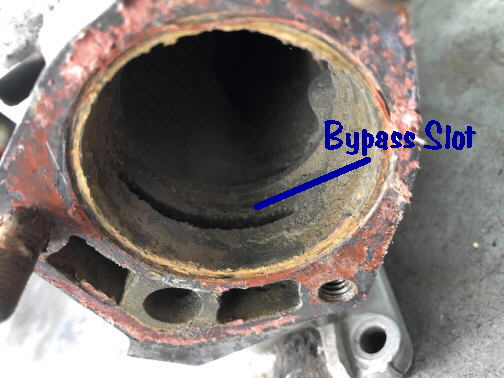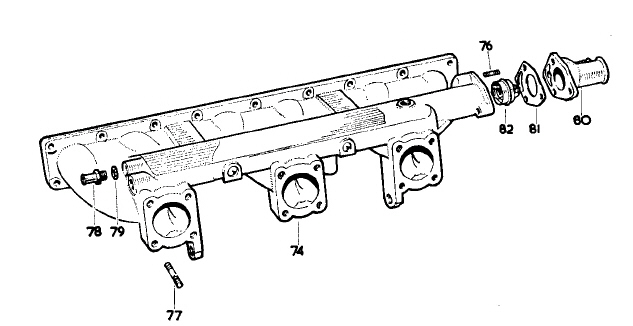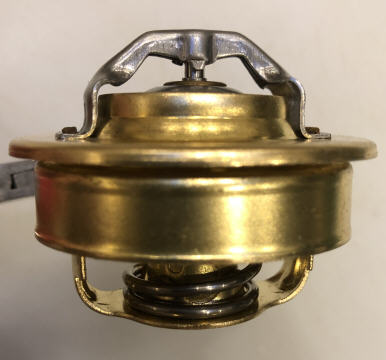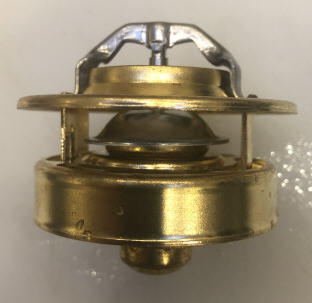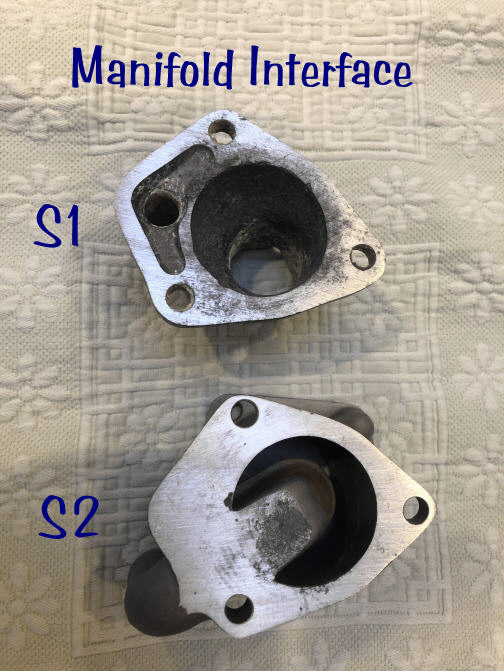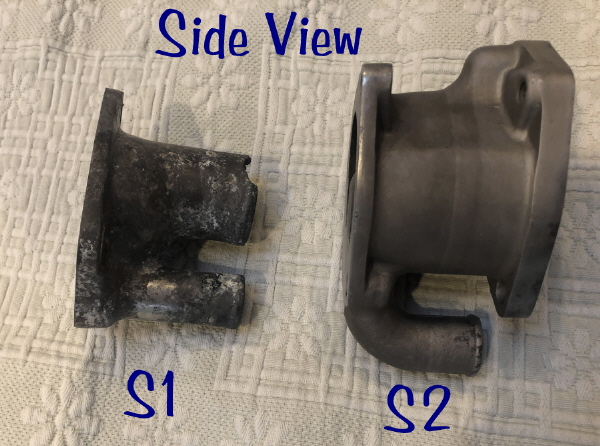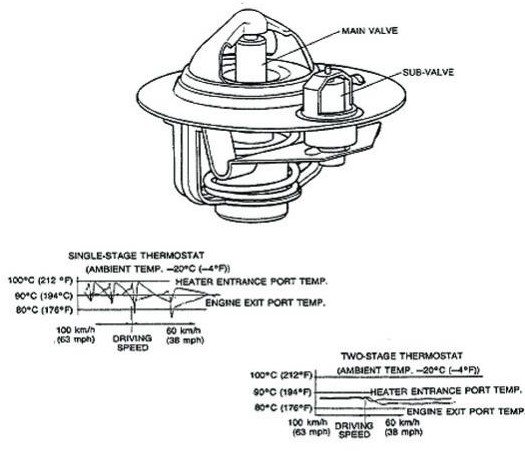| With
the introduction of the 4.2 engine, Jaguar had the opportunity to revise
some of its cooling system designs. By the mid-sixties, wax motor thermostats
were becoming commonplace, which as we've already learned, allow for high
flow rates and pressures.
The 4.2
manifold has an integral water passage. Coolant flows from back to front,
and straight out. While the engine is cool, bypass flow exits the
thermostat housing through a slot cut into the side of the passage, and
then out through a nipple cast into the cover. Like the earlier termostat
housings, the bypass is a slot cut in the side of the passage and so requires
a sleeved thermostat. The original c20766 wax thermostat incorporated a
sleeve, which moved backwards as it opens, covering the slot.
Because the wax motor is insensitive to pressure, the radiator cap used on 4.2's is rated at 7lbs or more. On later A/C equipped cars, the cap used was 13lbs. These pressures offered significant boiling point elevation over the earlier systems. Boiling Point Elevation vs Pressure
What
thermostats can you use with these cars? Bellows thermostats are out of
the question, not only because they are incompatible with the higher pressure
caps, but because there simply isn't enough room for the bellows in the
thermostat housing. This was likely a deliberate design choice, as there
is a ridge cast into the housing which prevents installation of any thermostat
morethan 1" high. There are several options for this engine:
1) The stock thermostat, C20766, is the best solution. Unfortunately, this thermostat has been out of production for decades, and is very hard to find. The stock opening temperature is 75c. 2) Workable
solution. Use a non-bypass wax thermostat. At some point, Jaguar superseded
C20766 with C27650, which is a 74C, single poppet thermostat. Flow section
of the original part is .81. This thermostat is still available under this
part number, but the specific design has changed over time. Although the
thermostat will not control the bypass passage, most of the flow will still
pass through the main poppet. This would be similar to the open bypass
application described in Chapter 3. The straight flow path of the 4.2 manifold
minimizes leakage when using a single poppet thermostat.
3) A possible improvement when using a single poppet thermostat would be to completely block the bypass using a brass stopper in the hose, and then use Stewart Components model 300 or 301, which is punctured to allow some bypass flow through the radiator. That would cause somewhat longer warm ups, but nobody is driving these cars in the winter.The Stewart has a very large 1.09 sq" flow cross section in Jaguar applications. It's also worth mentioning that these are available with 160, 170, or 192F opening temperatures. It's possible to cause damage, such as blown freeze plugs, if the bypass holes aren't large enough. 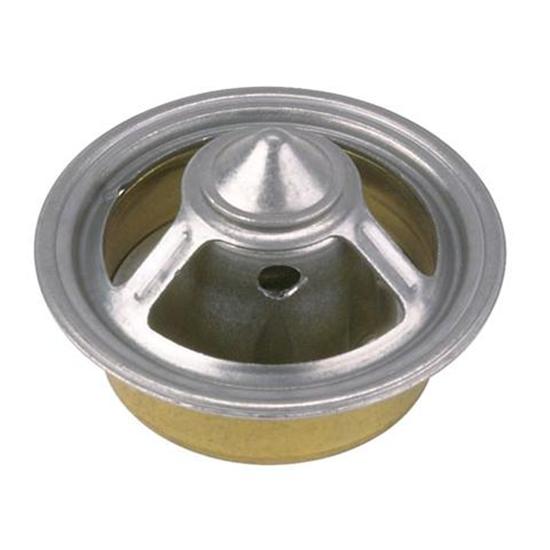
5) Use
a Series 2 thermostat housing, cover, and thermostat. The S2 thermostat
housing will bolt right up to an S1 4.2 manifold. It will completely block
off the bypass slot, and will provide an alternative bypass structure which
accomodates a two poppet thermostat. As will be explained in the S2 discussion,
there are many widely available thermostats that fit the S2 housing. The
air bleed in the cover can be blocked, so no changes would need to be made
to the radiator. Although the housing extends from the front of the manifold,
the stock hoses should fit with some trimming. A custom manifold-side gasket
can be cut from sheet stock.
Notes: 1) Many aftermarket 4.2 manifolds have been made with bypass slots that are located as close as 6mm below the flange. These manifolds cannot work correctly with any available thermostat, not even an original C20766. The only choices for these manifolds would be option 2, the single poppet thermostat, or option 5, the S2 E-Type housing extension. 2) Fail safe thermostats. Not appropriate for this application. This design has a spring loaded clip that locks the thermostat open if the temperature exceeds some predefined limit, usually 230F. The theory is that at these elevated temperatures, the thermostat will fail and collapse, permanently closed. But locking it open has no value. If you reach these temperatures, you will know it, and you should replace the thermostat as a matter of good practice. The wax motor will only fail if the temperature exceeds the melting point of the rubber seal, which won't happen unless the fluid is completely boiled out. At that point, it may or may not collapse. More likely it would stick at some mid point. While nominal risk is small, the true risk with fail safe designs is that the thermostat may lock without you knowing, in which case the thermostat would be inoperative and warm up will be extended. And none of the available fail-safes have bypass control sleeves. 3) SuperStat.
SuperStat is a trademark of Stant. Buyer beware: there are no SuperStats
that have a bypass sleeve for S1 E-Types. The label appears on Stant or
Gates thermostats with a weir valve design, and cannot be properly attached
to any other product. A weir valve is a short cylinder welded or pressed
into the flat poppet. The cylinder has a series of deep V-shaped notches.
The idea is that instead of exposing flow along the entire periphery of
the poppet, coolant will initially only flow through the apex of the V
notches. This gives more precise, gradual control at start-of-open, and
so tighter thermal regulation. Only when the thermostat has opened a good
part of the way will the periphery open up to maximize flow, giving a non
linear response to rising temperature.
<S1
E-Type 3.8 Main
Ford 351C>
Copyright©2019
CoolCat Express Corp
|
